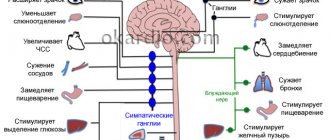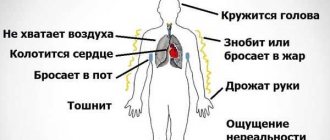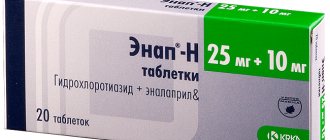Hyperhidrosis, or increased sweating during VSD, is considered an additional stressful situation for a person. People who sweat profusely must cope with a number of discomforts that the condition causes. To properly begin to treat hyperhidrosis, you need to consult a doctor, since therapy is prescribed individually for each patient, depending on the specific picture of the disease.
Causes of sweating during VSD
Vegetative-vascular dystonia is manifested by a disruption of communication between internal organs and the nervous system. Sometimes the acute phase of the disease causes serious disruption of the central nervous system and the conduction of nerve impulses to tissues and organs. At such a moment, the human body is under the influence of stress, as a result of which the normal functioning of the sebaceous and sweat glands is disrupted, and hyperhidrosis occurs. In addition, profuse sweating during VSD appears under the influence of the following factors:
- endocrine diseases and disorders;
- allergic reactions of the body;
- sedentary lifestyle;
- severe stress;
- emotional stress;
- negative impact of the environment.
Night sweats
Proper sleep conditions to prevent night sweats and more.
It is a signal of trouble in the body. Regular and severe sweating at night is a reason to consult a doctor, even if you seem to be feeling fine. Symptoms of VSD can develop gradually, and at first they practically do not appear.
Profuse night sweats can be perceived as a natural reaction of the body when, for example, a person takes antiviral and antibacterial drugs, as well as antipyretics.
Regular release of large amounts of sweat at night, which cannot be explained, must be regarded as a sign of the development of generalized hyperhidrosis.
With VSD, it is secondary in nature and can indicate that the person:
- is sick with tuberculosis or cancer pathologies;
- suffers from dysfunction of endocrine organs and/or other health disorders.
We recommend that you read
Causes of severe sweating after eating; Underarm pads to protect clothing from sweat; Our rating of the best antiperspirants that reliably protect against sweating.
Types of hyperhidrosis
There are several classifications of profuse sweating. Depending on the part of the body, a local type is distinguished, in which only some parts of the body sweat intensely: feet, armpits, face, groin. People suffering from VSD most often have sweaty palms. The second type is generalized, when increased sweating is accompanied evenly in all parts of the body. Another distribution of pathology is based on the sequence of its manifestation. If hyperhidrosis occurs as a result of hormonal disorders in adults or changes in the body in adolescents, then it is considered primary. The secondary form is provoked by VSD or another disease, and hyperhidrosis in this case is simply a symptom.
With tuberculosis, symptoms may appear at night.
People suffering from dystonia complain of profuse sweating during sleep, which also brings a lot of inconvenience. Night sweats with VSD are not associated with nervous tension or stress, since during sleep the body is at rest. The reason for this phenomenon is often the following factors:
- influenza or ARVI;
- taking antipyretic drugs;
- oncological lesions;
- hypo- and hyperthyroidism;
- tuberculosis;
- inflammation of the lymph nodes.
Night sweats, unlike all other types, cannot be cured with surgery.
Sudden attacks of sweat and heat
The sudden onset of heat and sweat is the most noticeable symptom of VSD.
These attacks can occur in the following situations:
- the lack of the ability of the central nervous system to restore balance between its departments, which leads to disruption of brain function. It instructs the body to quickly warm up due to vasoconstriction and a sharp flow of blood to the heart and head. In this case, the person experiences a surge in heat and sweating;
- situations in which activation of experiences and fears repressed from the subconscious occurs. That is, a person may not pay attention and not remember what scares him, but the nervous system immediately gives a signal to the brain and an attack of fever and sweat occurs;
- Also, the manifestation of heat occurs with obvious fear, worrying about little things.
In the case of a constant rush of heat and sweating, it is necessary to examine the entire body to exclude pathologies. It can also have a beneficial effect on the patient’s psyche, relieve tension and reduce attacks. Since the person will be sure that nothing threatens him.
Other symptoms
In addition to profuse sweating, VSD is characterized by the following manifestations:
With this disease, it is difficult for a person to concentrate on anything.
- frequent dizziness, headaches;
- blood pressure surges;
- irritability;
- depression;
- dyspnea;
- trembling of limbs;
- heart rhythm disturbance;
- numbness of the limbs;
- deterioration of coordination;
- impaired concentration.
VSD and hyperhidrosis how to treat
Vegetative-vascular dystonia is the cause of many unpleasant manifestations that affect the patient’s well-being and vital functions.
In most international reference books, this disease is often referred not to a separate disease, but rather to symptomatic manifestations indicating related pathologies.
In domestic practice, it is customary to classify VSD as a separate disease, which has its own clinical picture and symptoms.
- Content:
- Why do people sweat a lot with VSD?
- How to reduce sweating during VSD
A patient suffering from this pathology has to cope with various unpleasant manifestations. For example, vegetative-vascular dystonia and sweating occur in 80% of cases. What can help a patient suffering from excessive sweating?
Treatment of excessive sweating in vegetative-vascular dystonia is required in most cases of the development of the disease of the mixed or hypotonic type.
The development of the disease is preceded by: disorders in the human nervous system, stress, emotional disorders, psychosis, stress, hormonal disorders.
A powerful blow is dealt to the internal organs: heart, kidneys, liver, genitourinary system, etc. Hyperhidrosis with VSD is a direct consequence of such disorders.
In this case, a certain vicious circle is observed. The patient is stressed. The body begins to produce a large amount of sweat. The inconveniences associated with this lead to additional worries, which further aggravates the problem.
More people are finding out they have VSD as they seek effective treatment for sweating. After going through many doctors and trying seemingly “reliable” remedies, the patient finally sees an experienced doctor, who diagnoses him with dystonia.
It is worth noting that VSD with hyperhidrosis indicates serious disorders and disruptions in the functioning of the body. In medical practice, such manifestations are regarded as extremely complex. Therefore, the patient first of all needs to take care of restoring normal body functions and eliminating the causes of profuse, unpleasant sweating.
In this case, deodorants are not a very effective remedy, but medications and other therapies aimed at treating dystonia have a beneficial effect.
Sweating of the hands and armpits with vegetative-vascular dystonia can at least be reduced by using the following means.
- Psychotherapy. Most therapists recommend starting treatment with a visit to a psychologist. It is a generally accepted fact that the central nervous system in a state of excitement provokes increased sweating. By helping the patient overcome stress, the psychologist, at the same time, reduces the intensity of sweating. Herbal soothing drops can be effective in therapy. In severe cases, antidepressants are prescribed.
- Massage. After completing a month-long course of manual therapy, it is possible to create a strong barrier to stress. Although it is unlikely that you will be able to get rid of sweating palms and feet forever, you can eliminate the unpleasant symptom for quite a long time.
- Medicines. For VSD, sedative drops, antidepressants, and tranquilizers are prescribed, the main task of which is to help and strengthen the nervous system. Sweating of the palms, feet, and armpits is eliminated after the first week of taking these medications. A huge disadvantage of this therapy is that the body quickly gets used to the drugs. After completing the course of treatment, the doctor will prescribe a phased withdrawal from taking the drugs, with the least stress on the body. When sick, you break into a sweat even after relatively little stress. By helping the patient calmly respond to external stimuli, the psychologist prescribing medications will be able to reduce and even eliminate unpleasant manifestations.
- Personal hygiene. Excessive sweating in men or women requires taking serious measures against the consequences of hyperhidrosis. The smell of ammonia from sweat can be easily overcome by making it a rule to shower twice a day. Water procedures can also become a kind of antidepressant. Severe sweating in women can be reduced with the help of a properly selected antiperspirant. Physical activity, a healthy lifestyle, regular walks in the fresh air - all this helps to gradually reduce the manifestations of the disease.
In children, severe sweating is extremely difficult to treat. It is not advisable to prescribe sedatives and antidepressants. Cold sweat in an infant is an indication for a general examination, as it can indicate both VSD and other serious heart diseases.
With VSD, your arms, hands, legs and armpits may sweat. The main task of a specialist is to determine the exact cause of hyperhidrosis and eliminate the factors that provoke the disease. The therapist must determine why the patient's palms are excessively sweaty and rule out other possible catalysts for the disease.
In some cases, profuse sweating is the first sign indicating a pre-infarction condition, kidney or liver failure and other serious pathologies.
Professional medical care and personal hygiene can significantly alleviate various manifestations of VSD, including profuse sweating.
Based on materials from ponchikov.net
The ability to secrete sweat is a physiological norm for a healthy person, which occurs in stressful situations, heating the body or physical activity. The pathology manifests itself only in excessive sweating during VSD, accompanied by an unpleasant odor of sweat. In this case, we are talking about the presence of pathologies, the causes of which need to be identified and eliminated.
Among the many unpleasant manifestations of VSD is hyperhidrosis or increased sweating, which is not the worst symptom, but brings a lot of discomfort. As soon as a person begins to worry, his sweat glands start working actively. The unpleasant smell of discharge, which can be felt by people around, bothers the person, which is why he sweats even more.
The cause of hyperhidrosis must be established, because such a manifestation may be evidence of serious disorders in the body or the severity of dystonia. Refusal of timely treatment can lead to sweating not only in some areas, but also in the entire body.
Among the causes of increased sweating may be not only VSD, but also other diseases:
- rheumatism;
- genetic pathologies;
- tuberculosis;
- thyroid diseases;
- obesity.
In addition, a person can sweat intensely if the following factors are present:
- stress;
- changes in hormone levels;
- neurological disorders;
- emotional stress;
- lack of physical activity;
- manifestations of allergies;
- poor ecology in the place of residence.
Important! Excessive sweating of a person with VSD is a signal that the disease is severe, which means that it is necessary to seek the help of a specialist.
Source: https://fobii.org/vsd/vsd-i-gipergidroz-kak-lechit/
Diagnostics
To determine vegetative-vascular dystonia and establish the cause of increased sweating, the patient must tell the doctor in detail about the sensations and describe his complaints. Usually the diagnosis ends at this stage, since VSD is easy to determine. Additional examination includes consultation with a neurologist, cardiologist, endocrinologist and therapist. To fully diagnose the condition of the body, it is necessary to check each organ with an ultrasound and take laboratory tests: general and biochemical blood and urine tests.
Methods to reduce excessive sweating
Before treating hyperhidrosis, it is important to find out the origins of the phenomenon. When it is one of the symptoms of ill health, treatment should be based on eliminating the root cause. Otherwise, it is impossible to get rid of hyperhidrosis. The use of external agents will give a short-term effect, and the condition will worsen.
In other words, when excessive sweating is one of the signs of VSD, it is important to find out the nature of the dystonia itself and begin treatment. Correct therapy is possible only under the supervision of a doctor. He will conduct an examination, make a diagnosis and prescribe a set of medical measures.
Normalization of lifestyle
To prevent sweating due to stress, just follow simple rules.
The correct order of life plays an important role in eliminating the symptoms of VSD, including hyperhidrosis:
- maintaining a daily routine where sufficient time is allocated for rest;
- developing resistance to emotional stress and learning skills that will help cope with their impact;
- feasible physical activity;
- regular and nutritious meals.
To reduce the amount of sweat secretion, it is important not only to consume healthy foods with sufficient vitamins and minerals. It is recommended to minimize canned, salted and smoked foods. You should not overuse meat, especially fatty varieties.
Drug treatment
Complex therapy for VSD includes taking medications that relieve symptoms, including hyperhidrosis. For this purpose, the following may be prescribed:
- The most famous sedatives.
psychotropic drugs;
- medications that eliminate anxiety and also help overcome depression;
- tablets and mixtures with a sedative effect, without a hypnotic effect;
- neurometabolic brain stimulants.
From the first days of their use, results will become noticeable, and excess sweating will go away.
Psychotherapy
Many doctors believe that the fight against hyperhidrosis, as a symptom of VSD, should begin with a visit to a psychotherapist. This is explained by the fact that one of the reasons for high body humidity is the excited state of the central nervous system.
Using an individual approach, the psychotherapist will tell you how best to overcome stress and cope with anxiety and prescribe appropriate medications. The patient will learn to “control himself”, stop being nervous, and therefore stop sweating a lot.
Massage
A course of massage therapy can be a simple but very effective solution in combating the symptoms of VSD. A month of manual procedures can significantly increase stress resistance, remove signs of dystonia, and normalize sweating.
Treatment of hyperhidrosis
To relieve general tension, the patient can attend massage sessions.
Therapy for hyperhidrosis is aimed at eliminating its root cause - VSD. A mandatory component of getting rid of pathology is attending sessions with a psychologist or psychotherapist. This person will help you get rid of nervous tension and teach you how to independently cope with stressful situations and calm down. Thanks to this, the nervous system will return to normal and sweating will decrease. Massage therapy sessions will help relieve tension and stress. Drug treatment involves taking sedatives, antidepressants, or herbal teas and tinctures that have a calming effect. The dosage of the medicine is selected individually for each patient.
It is not enough to just treat hyperhidrosis; it is important to follow the rules of hygiene: take a shower at least 2 times a day, and if possible, more. Pharmacy deodorants or budget products such as zinc paste and Teymurov paste will help reduce sweating and unpleasant odor. At home, it is recommended to take baths with essential oils of coniferous trees. It is advisable to give up bad habits during the course of treatment.
Causes of manifestation
Among the many unpleasant manifestations of VSD is hyperhidrosis or increased sweating, which is not the worst symptom, but brings a lot of discomfort. As soon as a person begins to worry, his sweat glands start working actively. The unpleasant smell of discharge, which can be felt by people around, bothers the person, which is why he sweats even more.
The cause of hyperhidrosis must be established, because such a manifestation may be evidence of serious disorders in the body or the severity of dystonia. Refusal of timely treatment can lead to sweating not only in some areas, but also in the entire body.
Among the causes of increased sweating may be not only VSD, but also other diseases:
- rheumatism;
- genetic pathologies;
- tuberculosis;
- thyroid diseases;
- obesity.
In addition, a person can sweat intensely if the following factors are present:
- stress;
- changes in hormone levels;
- neurological disorders;
- emotional stress;
- lack of physical activity;
- manifestations of allergies;
- poor ecology in the place of residence.
Important! Excessive sweating of a person with VSD is a signal that the disease is severe, which means that it is necessary to seek the help of a specialist.












